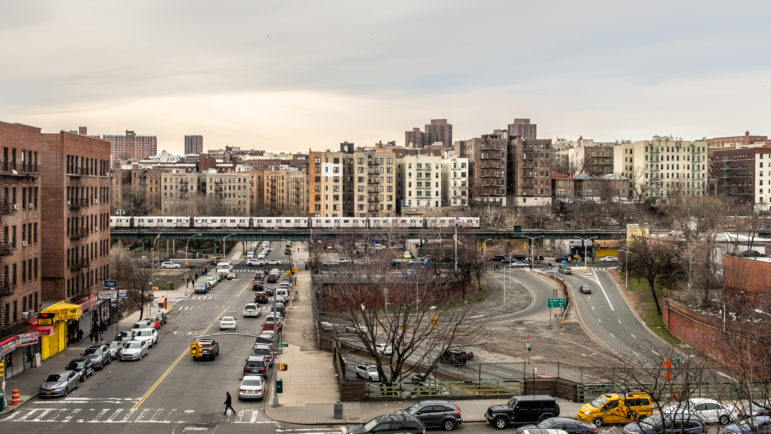‘Ensuring every New York City neighborhood has the same access and quality of life—whether you’re in Brownsville or the Upper West Side—will require a fair and comprehensive planning process.’

Adi Talwar
A view from the Grand Concourse of Jerome Avenue in the Bronx.Not all neighborhoods are created equally—and the pandemic showed that. Poor access to quality healthcare and good paying jobs are all challenges ingrained in the way we plan and build our cities. For too long, Black and brown neighborhoods have carried the burden of hosting the most essential services and infrastructure, from wastewater treatment plants to homeless shelters, while having limited access to the parks, transit, local career and entrepreneurship pathways, and permanently affordable housing that make our communities livable.
Ensuring every New York City neighborhood has the same access and quality of life—whether you’re in Brownsville or the Upper West Side—will require a fair and comprehensive planning process. The next mayor will need to revamp the way we plan in order to tackle historic under-investment, the legacy of environmental racism, and continued racial and economic segregation of our neighborhoods and schools. To do this, we must re-imagine city building and investments from the highest to the most granular level.
First, shape a citywide plan to aim at and ensure a fair distribution of essential infrastructure and neighborhood amenities, modeled off comprehensive planning and budgeting processes from municipalities like Seattle and Minneapolis. Comprehensive planning must be responsive to the conditions of individual neighborhoods while taking a holistic approach to the clearly stated goals of tackling unevenness of community services and infrastructure citywide.
To meet these goals, data indicators and monitoring programs, like the ones championed in Seattle’s planning process, can create benchmarks to measure how each neighborhood approaches racial equity and climate justice targets. We can layer all types of physical and demographic data, from proximity by foot to parks or transit, levels of housing or job insecurity, or public health challenges like extreme heat or air quality, and use the findings to adjust policy and investment strategies.
This comprehensive strategy can ensure that transit and amenity-rich neighborhoods support greater racial and income diversity with affordable and supportive housing. In addition, a data-centered approach will serve to create greater clarity in the capital investment process and marshal city dollars to chronically under-invested Black and brown communities.
Second, the next mayor must fight like hell to increase community ownership in those neighborhoods most in need. Formerly red-lined neighborhoods are at risk of rising property values from new housing or infrastructure. To preemptively combat housing insecurity or displacement, the city must simultaneously fight to increase opportunities for community wealth building like Black entrepreneurship and cooperative businesses. Proactive ownership strategies like this are being implemented in cities like Washington D.C. or Seattle, transferring underutilized city properties to Black-led nonprofits.
Lastly, the next mayor will need to bridge communities and city agencies to plan collaboratively and democratically by investing in ground-up civic infrastructure. Though some of the existing challenges to Community Boards are being addressed today, the city will need to go beyond the status quo in order to develop a more ingrained feedback loop for planning and decision-making.
New York City must invest in a variety of new tools and programs that meet residents where they are to overcome barriers to access. The next mayor can build up public sector planning capacity and embed private sector design and planning facilitators across every community district, looking to London’s Public Practice initiative as a model. Greater investments in social infrastructure, like libraries and community centers, can also provide physical civic spaces for residents to gather freely and co-design with city government. Lastly, increasing both high-tech and low-tech tools like livestream town halls or polling via text message can increase participation for those facing persistent barriers, but will require universal broadband.
The next mayor will be challenged with rebuilding New York City after the pandemic, creating new housing, jobs, and a vibrant public realm. Yet, the most vulnerable New Yorkers have historically been left out of the growth model and previous recovery plans. Rather than focusing exclusively on the number of jobs or housing units, our city’s next leaders must center inclusive growth by improving the quality of life and place for the hardest-hit communities first.
We need to be laser-focused on repairing the greatest challenges we face today, which are all expressed in the built environment—a widening racial wealth gap, rising income inequality, and the disproportionate effects of a present climate crisis. To achieve that, the next mayor must keep the process simple but democratic, holistic while neighborhood-led, to shape a truly equitable city in their legacy.
Elena Conte is a senior fellow at the Pratt Center for Community Development, with nearly two decades of experience in community-based planning. Guillermo Gomez is program director at the Urban Design Forum, leading their 21 Visions for 2021 initiative, a resource and call for action for New York City’s next mayor. Beatrice Sibblies is founder and managing partner of BOS Development, a community-focused real estate development firm based in Harlem.








